外研版(2019)选择性必修第一册Unit 6 Nurturing nature Using Language课件(共12张PPT)
文档属性
| 名称 | 外研版(2019)选择性必修第一册Unit 6 Nurturing nature Using Language课件(共12张PPT) | 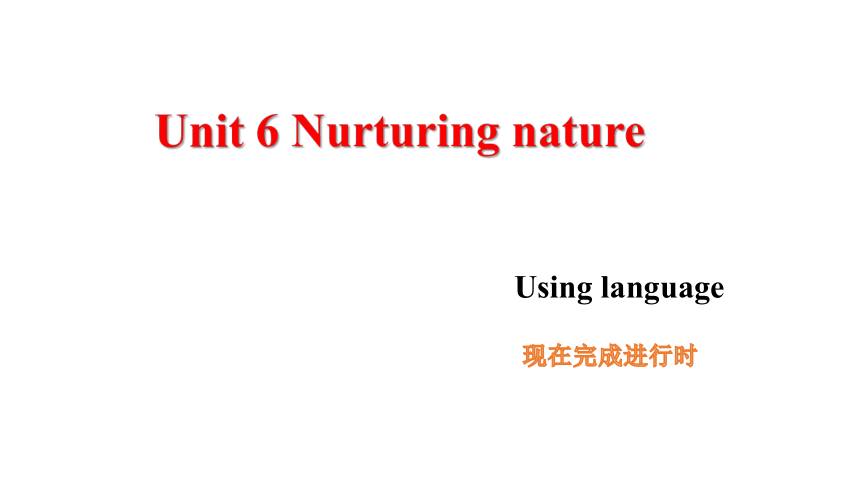 | |
| 格式 | ppt | ||
| 文件大小 | 567.0KB | ||
| 资源类型 | 教案 | ||
| 版本资源 | 外研版(2019) | ||
| 科目 | 英语 | ||
| 更新时间 | 2025-08-05 23:16:57 | ||
图片预览

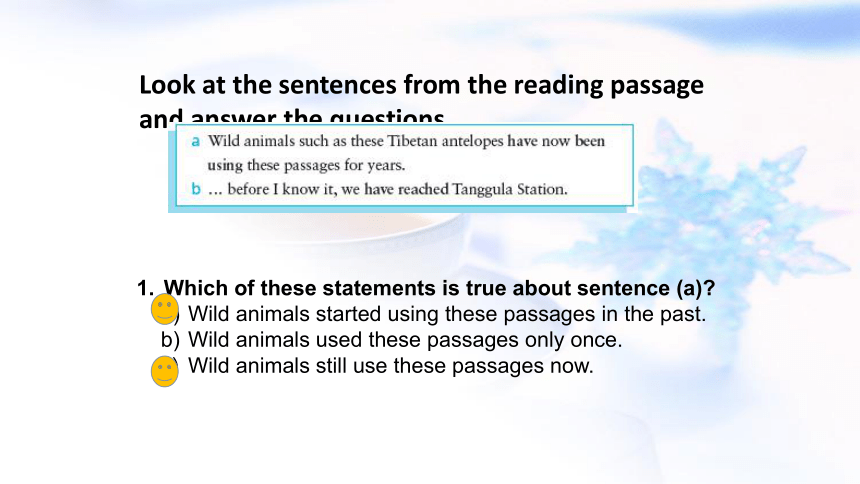
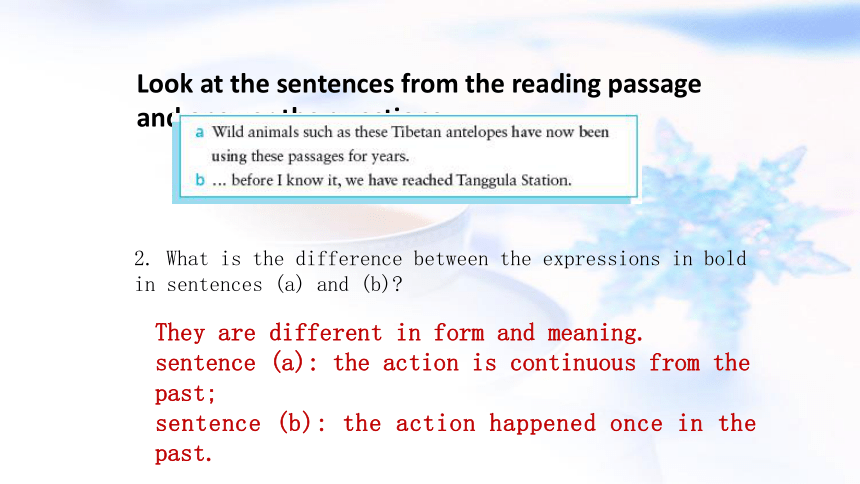
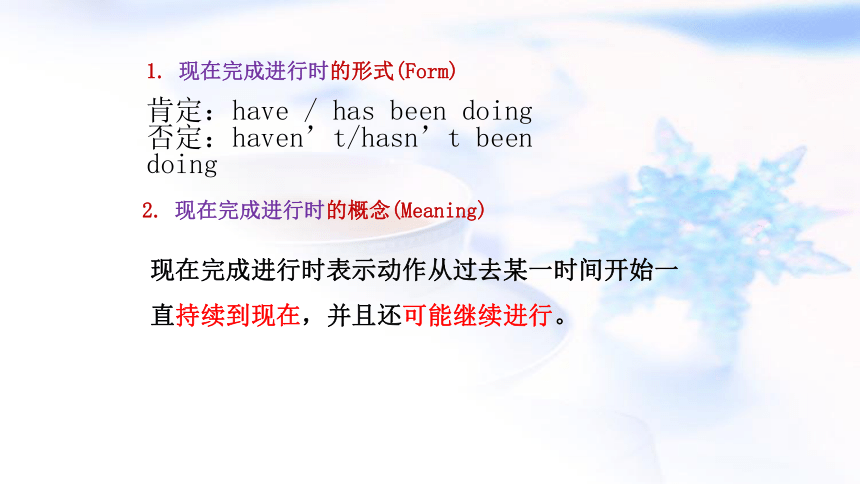
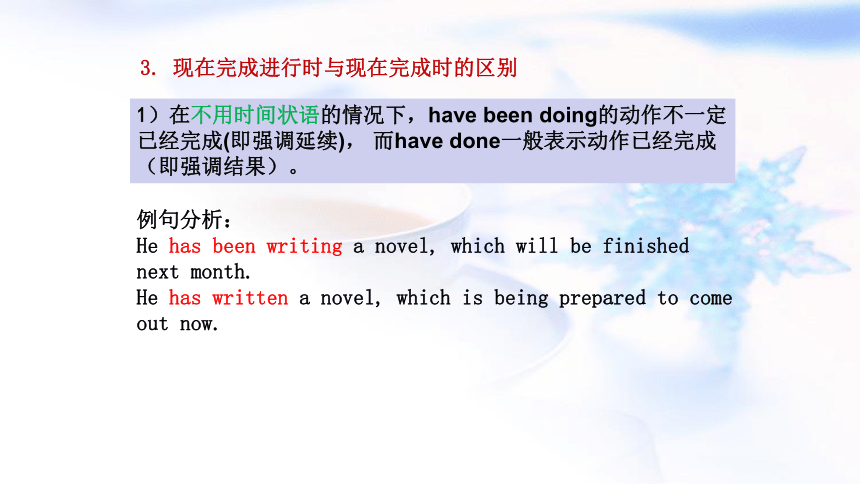
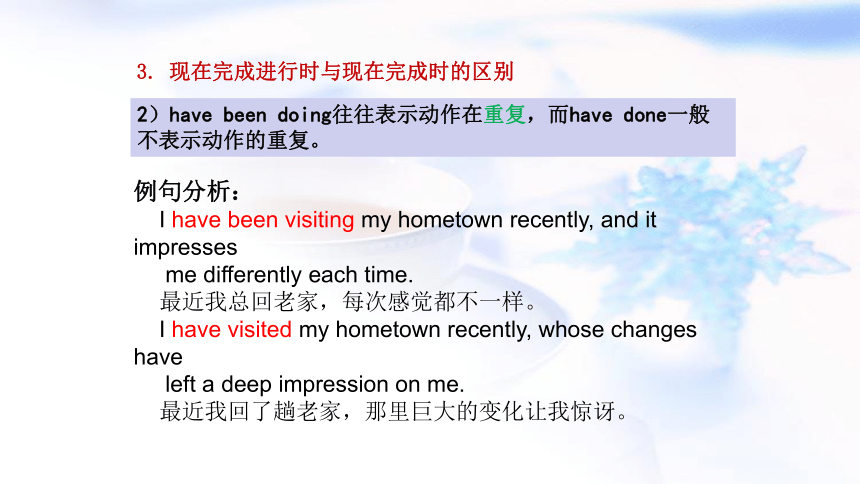
文档简介
(共12张PPT)
Unit 6 Nurturing nature
Using language
Which of these statements is true about sentence (a)
Wild animals started using these passages in the past.
Wild animals used these passages only once.
Wild animals still use these passages now.
Look at the sentences from the reading passage and answer the questions.
Look at the sentences from the reading passage and answer the questions.
They are different in form and meaning.
sentence (a): the action is continuous from the past;
sentence (b): the action happened once in the past.
2. What is the difference between the expressions in bold in sentences (a) and (b)
肯定:have / has been doing
否定:haven’t/hasn’t been doing
现在完成进行时表示动作从过去某一时间开始一直持续到现在,并且还可能继续进行。
1. 现在完成进行时的形式(Form)
2. 现在完成进行时的概念(Meaning)
1)在不用时间状语的情况下,have been doing的动作不一定已经完成(即强调延续), 而have done一般表示动作已经完成(即强调结果)。
例句分析:
He has been writing a novel, which will be finished next month.
He has written a novel, which is being prepared to come out now.
3. 现在完成进行时与现在完成时的区别
2)have been doing往往表示动作在重复,而have done一般不表示动作的重复。
例句分析:
I have been visiting my hometown recently, and it impresses
me differently each time.
最近我总回老家,每次感觉都不一样。
I have visited my hometown recently, whose changes have
left a deep impression on me.
最近我回了趟老家,那里巨大的变化让我惊讶。
3. 现在完成进行时与现在完成时的区别
3)have been doing与所有进行时态一样带有感彩,可使表达显得生动;而现在完成时往往只表明一个事实、一种影响或结果,不带感彩。
例如:
Recently he has always been helping me.
最近他总帮我(感激 )。
Recently he has helped me a lot.
最近他帮了我很多(客观陈述)。
3. 现在完成进行时与现在完成时的区别
1.Mary really hard on his book and thinks he’ll have finished it by Friday.
worked B. has been working
C. had worked D. has worked
2.—Where is Peter I can't find him anywhere.
—He went to the library after breakfast and _____ his essay there ever since.
wrote B. had written
C. has been writing D. is writing
Practice: Activity 2
1. have been hearing
2. has been making
3. is moving
4. have been flying
5. have been given
6. have been using
Practice: Activity 3
Look at the charts and make sentences using the present perfect continuous tense.
1. The number of trees has been increasing in the last 20 years.
2. Desert areas have been reducing in the last 20 years.
3. Butterfly population has been increasing / has been becoming larger and larger in the last 20 years.
Practice
Unit 6 Nurturing nature
Using language
Which of these statements is true about sentence (a)
Wild animals started using these passages in the past.
Wild animals used these passages only once.
Wild animals still use these passages now.
Look at the sentences from the reading passage and answer the questions.
Look at the sentences from the reading passage and answer the questions.
They are different in form and meaning.
sentence (a): the action is continuous from the past;
sentence (b): the action happened once in the past.
2. What is the difference between the expressions in bold in sentences (a) and (b)
肯定:have / has been doing
否定:haven’t/hasn’t been doing
现在完成进行时表示动作从过去某一时间开始一直持续到现在,并且还可能继续进行。
1. 现在完成进行时的形式(Form)
2. 现在完成进行时的概念(Meaning)
1)在不用时间状语的情况下,have been doing的动作不一定已经完成(即强调延续), 而have done一般表示动作已经完成(即强调结果)。
例句分析:
He has been writing a novel, which will be finished next month.
He has written a novel, which is being prepared to come out now.
3. 现在完成进行时与现在完成时的区别
2)have been doing往往表示动作在重复,而have done一般不表示动作的重复。
例句分析:
I have been visiting my hometown recently, and it impresses
me differently each time.
最近我总回老家,每次感觉都不一样。
I have visited my hometown recently, whose changes have
left a deep impression on me.
最近我回了趟老家,那里巨大的变化让我惊讶。
3. 现在完成进行时与现在完成时的区别
3)have been doing与所有进行时态一样带有感彩,可使表达显得生动;而现在完成时往往只表明一个事实、一种影响或结果,不带感彩。
例如:
Recently he has always been helping me.
最近他总帮我(感激 )。
Recently he has helped me a lot.
最近他帮了我很多(客观陈述)。
3. 现在完成进行时与现在完成时的区别
1.Mary really hard on his book and thinks he’ll have finished it by Friday.
worked B. has been working
C. had worked D. has worked
2.—Where is Peter I can't find him anywhere.
—He went to the library after breakfast and _____ his essay there ever since.
wrote B. had written
C. has been writing D. is writing
Practice: Activity 2
1. have been hearing
2. has been making
3. is moving
4. have been flying
5. have been given
6. have been using
Practice: Activity 3
Look at the charts and make sentences using the present perfect continuous tense.
1. The number of trees has been increasing in the last 20 years.
2. Desert areas have been reducing in the last 20 years.
3. Butterfly population has been increasing / has been becoming larger and larger in the last 20 years.
Practice
